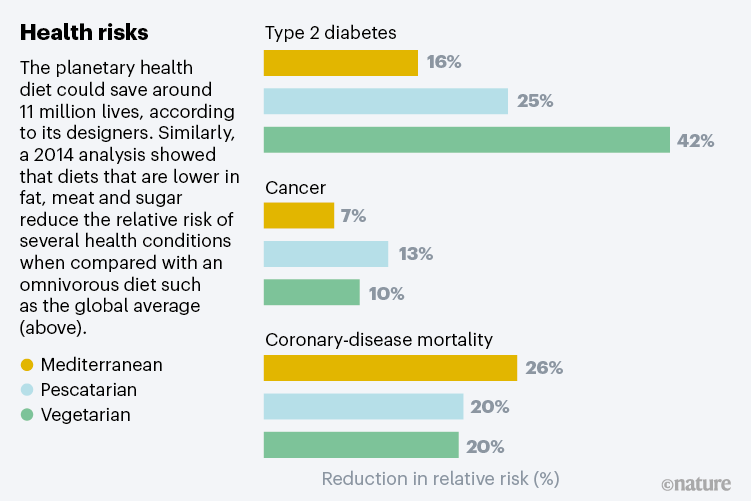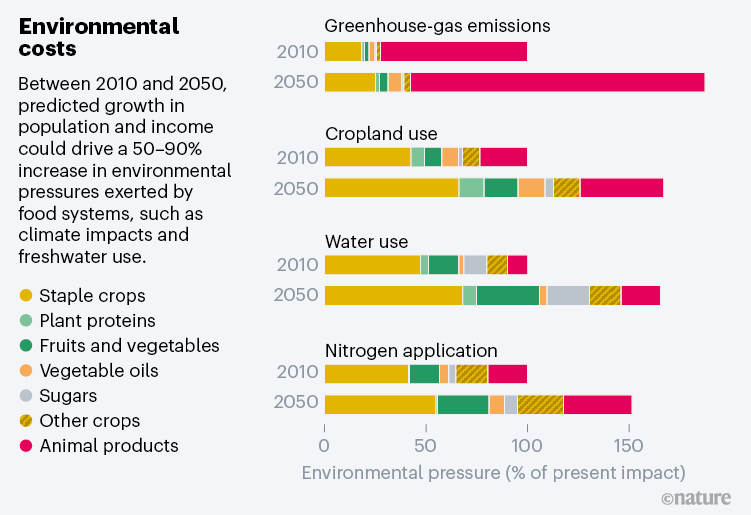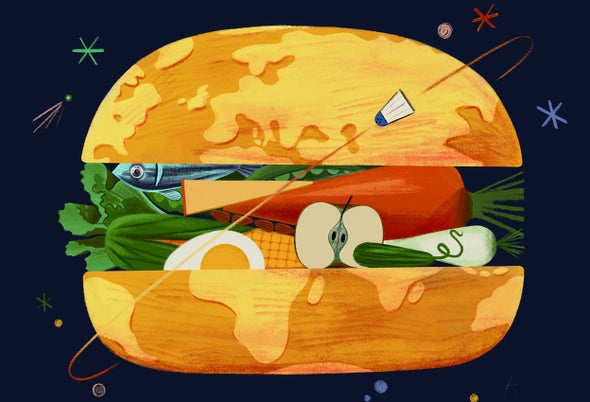A clutch of fishing villages dot the coast near Kilifi, north of Mombasa in Kenya. The waters are home to parrot fish, octopus and other edible species. But despite living on the shores, the children in the villages rarely eat seafood. Their staple meal is ugali, maize (corn) flour mixed with water, and most of their nutrition comes from plants. Almost half the kids here have stunted growth—twice the national rate.
In 2020, Lora Iannotti, a public-health researcher at Washington University in St. Louis, and her Kenyan colleagues asked people in the villages why the children weren’t eating seafood, even though all the parents fish for a living; studies show that fish and other animal-source foods can improve growth. The parents said it made more financial sense for them to sell their catch than to eat it.
So, Iannotti and her team are running a controlled experiment. They have given fishers modified traps that have small openings that allow young fish to escape. This should improve spawning and the health of the overfished ocean and reef areas over time, and eventually increase incomes, Iannotti says. Then, for half the families, community health workers are using home visits, cooking demonstrations and messaging to encourage parents to feed their children more fish, especially plentiful and fast-growing local species such as ‘tafi’, or white spotted rabbitfish (Siganus canaliculatus) and octopus. The scientists will track whether children from these families eat better and are growing taller than ones who don’t receive the messaging.
The aim of the experiment, says Iannotti, is to understand “which sea foods can we choose that are healthy for the ecosystem as well as healthy in the diet”. The proposed diet should also be culturally acceptable and affordable, she says.

Iannotti is wrestling with questions that are a major focus of researchers, the United Nations, international funders and many nations looking for diets that are good for both people and the planet. More than 2 billion people are overweight or obese, mostly in the Western world. At the same time, 811 million people are not getting enough calories or nutrition, mostly in low- and middle-income nations. Unhealthy diets contributed to more deaths globally in 2017 than any other factor, including smoking. As the world’s population continues to rise and more people start to eat like Westerners do, the production of meat, dairy and eggs will need to rise by about 44% by 2050, according to the UN Food and Agriculture Organization (FAO).
That poses an environmental problem alongside the health concerns. Our current industrialized food system already emits about one-quarter of the world’s greenhouse-gas emissions. It also accounts for 70% of freshwater use and 40% of land coverage, and relies on fertilizers that disrupt the cycling of nitrogen and phosphorus and are responsible for much of the pollution in rivers and coasts.
In 2019, a consortium of 37 nutritionists, ecologists and other experts from 16 countries—the EAT–Lancet Commission on Food, Planet, Health—released a report that called for a broad dietary change that would take into account both nutrition and the environment. A person following the EAT–Lancet reference diet would be ‘flexitarian’, eating plants on most days and occasionally a small amount of meat or fish.
The report provoked a flurry of attention towards sustainable diets, and some criticism about whether it was practical for everyone. Some scientists are now trying to test environmentally sustainable diets in local contexts, without compromising nutrition or damaging livelihoods.
“We need to make progress toward eating diets that have dramatically lower ecological footprints, or it’ll be a matter of a few decades before we start to see global collapses of biodiversity, land use and all of it,” says Sam Myers, director of the Planetary Health Alliance, a global consortium in Boston, Massachusetts, that studies the health impacts of environmental change.
Emissions on the menu
Producing food generates so much greenhouse-gas pollution that at the current rate, even if nations cut all non-food emissions to zero, they still wouldn’t be able to limit temperature rise to 1.5 °C—the climate target in the Paris agreement. A large proportion of emissions from the food system—30–50%, according to some estimates—comes from the livestock supply chain, because animals are inefficient at converting feed to food.
In 2014, David Tilman, an ecologist at the University of Minnesota in Saint Paul, and Michael Clark, a food-systems scientist at the University of Oxford, UK, estimated that changes in urbanization and population growth globally between 2010 and 2050 would cause an 80% increase in food-related emissions.

But if everyone, on average, ate a more plant-based diet, and emissions from all other sectors were halted, the world would have a 50% chance of meeting the 1.5 °C climate-change target. And if diets improved alongside broader changes in the food system, such as cutting down waste, the chance of hitting the target would rise to 67%.
Such findings are not popular with the meat industry. For example, when in 2015, the US Department of Agriculture was revising its dietary guidelines, which happens every five years, it briefly considered factoring in the environment after researchers lobbied the advisory committee. But the idea was overruled, allegedly in response to industry pressure, says Timothy Griffin, a food-systems scientist at Tufts University in Boston, who was involved in the lobbying effort. Nonetheless, people took notice of the attempt. “The biggest accomplishment is it brought a lot of attention to the issue of sustainability,” he says.
The EAT–Lancet Commission, which was funded by Wellcome, a UK-based charity, helped to build a stronger case. Nutritionists reviewed the literature to craft a basic healthy diet composed of whole foods. Then the team set environmental limits for the diet, including carbon emissions, biodiversity loss and the use of fresh water, land, nitrogen and phosphorus. Breaching such environmental limits could make the planet inhospitable to humans.

They ended up with a diverse and mainly plant-based meal plan (see ‘Healthy eating’). The maximum red meat the 2,500-calorie per day diet allows in a week for an average-weight 30-year-old is 100 grams, or one serving of red meat. That’s less than one-quarter of what a typical American consumes. Ultra-processed foods, such as soft drinks, frozen dinners and reconstituted meats, sugars and fats are mostly avoided.
This diet would save the lives of about 11 million people every year, the commission estimated. “It is possible to feed 10 billion people healthily, without destroying ecosystems further,” says Tim Lang, food-policy researcher at the City University of London and a co-author of the EAT–Lancet report. “Whether the hardliners of the cattle and dairy industry like it or not, they are really on the back foot. Change is now inevitable.”
Many scientists say the EAT–Lancet diet is excellent for wealthy nations, where the average person eats 2.6 times more meat than their counterpart in low-income countries, and whose eating habits are unsustainable. But others question whether the diet is nutritious enough for those in lower-resource settings. Ty Beal, a scientist based in Washington DC with the Global Alliance for Improved Nutrition, has analysed the diet in unpublished calculations and found that it provides 78% of the recommended zinc intake and 86% of calcium for those over 25 years old, and only 55% of the iron requirement for women of reproductive age.
Despite these critiques, the diet has put environmental concerns front and centre.“Until EAT–Lancet, I don’t think it had been at the top of policymakers’ minds that sustainability should be integrated into this global conversation about dietary change,” says Anne Elise Stratton, a food-systems scientist at the University of Michigan in Ann Arbor.
The diet is not a one-size-fits-all recommendation, stresses Marco Springmann, a food scientist at the University of Oxford who was part of the EAT–Lancet core modelling team.
Since the report was published, public-health scientists around the world have been studying how to make the diet realistic for people the world over, whether an overweight adult or an under-nourished child.
Rich diets
Nutrition researchers know that most consumers do not follow dietary guidelines. So some scientists are exploring ways to convince people to adopt healthy, sustainable diets. In Sweden, Patricia Eustachio Colombo, a nutrition scientist at the Karolinska Institute in Stockholm, and her colleagues are quietly testing a sustainable diet in schools. Their work piggybacks on a social movement that began in Scandinavian countries called the New Nordic Diet, which promotes consumption of traditional, sustainable foods such as seasonal vegetables and free-range meat.
Eustachio Colombo and her colleagues used a computer algorithm to analyse existing school lunches at a primary school with about 2,000 students. The algorithm suggested ways to make them more nutritious and climate-friendly, such as reducing the amount of meat in a typical stew and adding more beans and vegetables. The children and parents were informed that lunches were being improved, but did not know details, Eustachio Colombo says. Most kids did not notice, and there was no more food waste than earlier. The same experiment is now being re-run in 2,800 children.
“School meals are a near unique opportunity to foster sustainable dietary habits. The dietary habits we develop as children, we tend to stick to them into adulthood,” Eustachio Colombo says.

The diet is very different from the EAT–Lancet one, she says. It is cheaper and includes more starchy foods such as potatoes, which are a staple of Swedish cuisine. It is also more nutritious and culturally acceptable, she says. “This highlights the importance of tailoring the EAT-Lancet diet to the local circumstances in each country or even within countries,” she says.
Across the Atlantic, some academics and restaurateurs are trialling the diet in low-income settings. In Baltimore, Maryland, a collaboration between a catering business and a restaurant, both forced to close during the COVID-19 pandemic, started taking donations and providing free meals based on the EAT-Lancet diet to families who live in ‘food deserts’—areas where there is little access to affordable, nutritious food. One meal had salmon cakes with mixed seasonal vegetables, Israeli couscous and creamy pesto sauce.
Researchers at the Johns Hopkins University School of Medicine in Baltimore surveyed 500 people who tried the meals and found that 93% of the 242 people who completed the survey said they either loved or liked it. The downside? Each donation-funded meal cost US$10—five times the amount currently provided by the US food-stamp programme.
“It’s very clear that if you have a huge shift in diets, you could swing the environment impact for the better, but there’s cultural barriers and economic barriers to that,” says Griffin.
Hard to stomach
For researchers exploring future diets in some low- or middle-income nations, one hurdle is finding out what people are eating in the first place. “It’s literally like a black box to me right now,” says Purnima Menon at the International Food Policy Research Institute in Delhi, who has been studying diets in India. The data on what people are eating are a decade old, she says.
Getting that information is crucial, because India ranks 101 out of 116 countries in the Global Hunger Index and has the greatest number of children who are too thin for their height.
Using what’s available, Abhishek Chaudhary, a food-systems scientist at the Indian Institute of Technology Kanpur, who was part of the EAT–Lancet team, and his colleague Vaibhav Krishna at the Swiss Federal Institute of Technology in Zurich used a computer program and local environmental data on water, emissions, land use and phosphorus and nitrogen use to design diets for all of India’s states. The algorithm suggested diets that would meet nutritional requirements, cut food-related emissions by 35% and wouldn’t stress other environmental resources. But to grow the required amount of food would require 35% more land—which is impractical in the overcrowded nation—or higher yields. And food costs would be 50% higher.
Healthy, sustainable diets are expensive elsewhere, too. The dietary diversity advised by EAT–Lancet —nuts, fish, eggs, dairy and more—is impossible to access for millions of people, says Iannotti.
In fact, for the average person to eat the diet in 2011—the most recent data set available on food prices—would have cost a global average of $2.84 per day, about 1.6 times higher on average than the cost of a basic nutritious meal.
There are other impracticalities. Take restrictions on meat, for instance. In places with nutrient deficiencies and where the diet’s prescribed foods are not available, animal-source products are a crucial source of easily bioavailable nutrients in addition to plants, Iannotti says. In many places in low-income nations, farming systems are small-scale and include both crops and domesticated animals, which can be sold in times of family need, says Jimmy Smith, director-general of the International Livestock Research Institute in Nairobi.
“The farmer in the highlands of Ethiopia doing dairy has three or four animals in his or her backyard, and each of these animals is a member of the family, they have names,” he says.
Menon says that for now, scientists in low- and middle-income regions are more concerned about delivering nutrition than preserving the environment. The FAO has organized a committee to do a much more comprehensive analysis than EAT–Lancet’s. The new analysis will be more globally inclusive and include topics such as food security and sustainability of the livestock sector, says Iannotti, who is part of the committee. It will be published in 2024. “They don’t feel as if it was entirely balanced or holistic in its review of the evidence,” she says. “Let’s go further and make sure we have evidence from around the world.”
The way to find sustainable diets in poor nations is by working closely with communities and farmers, as in Kilifi, scientists say. Clark, having mapped out diet at a global scale using model-based projections, thinks that food-system scientists now need to find the local adjustments and fixes to get people to eat better.
“People working in food sustainability need to go into communities and ask, ‘hey, what’s good for you?’” he says. “And then, given that baseline, how can we start working towards outcomes that those communities are interested in.”
This article is reproduced with permission and was first published on December 1 2021.


